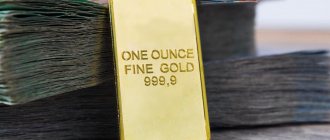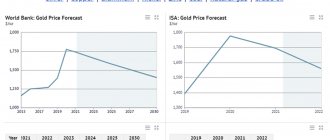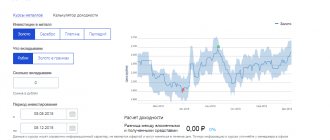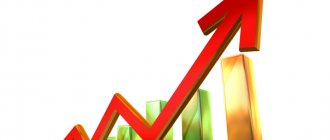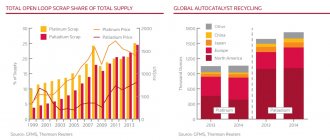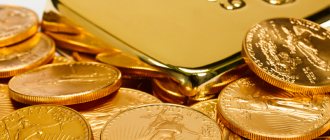Illustrative photo: Getty Images / Yevgeniy Sambulov Gold is one of the most popular investment instruments. And against the backdrop of a decline in its value, prospects for profitable investments arise. Read more in Nurfin's article.
The price of gold in 2021 fluctuated and depreciated from 26,128 tenge to 24,297 tenge per gram (January 1 – August 17), according to the National Bank.
The minimum price for this period was reached on March 9 – 22,862 tenge per gram.
At the same time, despite the general downward trend in prices, Kazakhstanis continued to actively buy gold.
Thus, in June 2021, a record number of gold bars were purchased - 3,188 units, the total weight of which is 124.2 kilograms.
According to the exchange telegram channel Tim Martynov, investing in gold can become justified and bring income in the medium term. However, we should not forget about the risks.
Gold price in 2021. Source: National Bank of Kazakhstan
What will happen to gold in 2021?
Forecast from the British bank HSBC
Inflows into exchange-traded funds have been phenomenal in 2021, proving to be one of the main factors behind the precious metal's record rally. Next year the figure will most likely not be as outstanding.
Jim Steele, chief precious metals analyst at HSBC, noted that the average gold price in 2021 will be $1,965 per ounce. This will be influenced by the following factors: accommodative monetary policy and a reduction in geopolitical risk under the reign of Joe Biden in the United States. Consequently, there will be fewer risks, and therefore the rate will decrease.
Analyst comment: “The yellow metal reacts to geopolitical risks. If trade conflicts between the US and other countries are resolved, gold will suffer. $1,965 per ounce is the average annual rate of the precious metal, and not a forecast for the end of next year. At the beginning of the year the rate will increase and then decrease. It should be borne in mind that the average annual rate means the following: the yellow metal can rise in price to $2,000 and then drop below $1,900 per ounce. The gold market has benefited from monetary stimulus and low interest rates this year. In most cases, the rally in this market is supported by two problems - debt and liquidity. This market is now benefiting from these challenges as very accommodative monetary policy has been in place for a long time. Low interest rates make the yellow metal more attractive as an asset, reducing the opportunity cost of owning it. The seasonality factor now plays a lesser role for the precious metal. In the past, demand has increased during Diwali, the Indian Festival of Lights, and around Chinese New Year. However, recently, seasonal phenomena have not had a significant impact on the market.”
Forecast of the British dealer "Direct Bullion"
Direct Bullion analysts predict that gold price records will be updated in 2021 due to economic instability and increased demand for this commodity asset.
According to the forecast, an ounce of the precious metal will rise in price by 40%, that is, it could reach $2,800 during the first 6-7 months of next year.
Paul Withers, director of , commented on the forecast: “Next year will be a tremendous year for the precious metals market, particularly for platinum, silver and gold. The price of gold could jump to $2,800 per ounce, so now is the time to buy the physical precious metal, which is the main defensive asset. Investments in physical assets provide security in volatile markets. Our customers often say: “I wish I had bought more!”
Forecast from the American
Edward Moya, the company's senior analyst, believes gold could still hit new records despite lack of growth during November. In his opinion, an ounce of the precious metal will rise in price during the first half of 2021 to $2,300.
Moya believes positive news about coronavirus vaccines has triggered a sell-off in the precious metals market as investors believe a speedy economic recovery is possible.
Analyst comment: “Yellow metal is inconvenient to trade in the current volatility. Investors bought it primarily because it is considered a defensive asset. In recent weeks, all we have heard is news about vaccines, so there is hope for economic growth. Hence the sale of protective assets. However, no one knows what will happen in the future with the pandemic and the economy. Consequently, in conditions of such uncertainty, the precious metal will remain an attractive investment object by the end of this year and throughout the next year. The crisis state of the economy will lead to the need for further stimulus measures in the United States, which means that the American currency will lose the lion’s share of its purchasing power next year.”
About the three main factors for rising gold prices
We are talking about an increase in coronavirus cases, a worsening situation in the stock market and an increase in unemployment in the world.
Moya’s direct speech: “In the United States, the number of new coronavirus cases is increasing by more than 200 thousand per day. This will lead to stricter quarantine in most states, which will force the authorities to act quickly, that is, to make appropriate decisions on the stimulus package. Congress will look past petty squabbles and take action when some states find their hospitals overcrowded and resources stretched thin. The troubling news about the pandemic will ultimately lead to the resolution of all disputes regarding fiscal stimulus."
Another major catalyst for gold prices will be that stock indices are forecast to be down 3-5% from current levels next year. This will support the popularity of the precious metal. Investor sentiment in stock markets will worsen. The news about the vaccine is already included in the current stock prices, and there are no other factors for the stock market rally yet. Therefore, over the next few quarters, we won’t expect much profit from them.”
The third catalyst for rising gold prices will be unemployment in the US and other countries: “The labor market has been seriously damaged, which will lead to an increase in the number of applications for unemployment benefits. Investors will be concerned about the loss of jobs in the economy. There will be even more bankruptcies of small businesses, so the authorities and central banks will have to fork out money.”
According to the analyst, the trajectory of the gold price at the end of this year and the first half of next year will not disappoint investors.
Moya's direct speech: “I would not be surprised if the gold rate is in the range of 1950-2000 dollars per ounce. By the end of the year, Congress will resume negotiations on a stimulus package, and the Fed will announce upcoming monetary measures at its meeting on December 16. Most likely, the US central bank will report an increase in purchases of Treasury bonds. In addition, if the Fed does not control the yield curve, then its representatives will at least hint at when this will happen. There will be volatility in the gold market. Congress will need to make an appropriate decision, and all these lockdowns, quarantines and school closures in certain states will increase pressure on the central government. In the first half of next year, the yellow metal will rise in price significantly. It is quite possible that even a new record will be set during this period. Everything will depend on the situation around the pandemic and the effectiveness of the vaccines. The rate may well reach $2,300 per ounce. It is important to remember that once markets recover from the pandemic, they will expect news of higher inflation rates. In such conditions, the precious metal will rise in price. For ten years, no one talked about inflation in the United States. Now the corresponding risks will make themselves felt again. That's why many investors still believe the yellow metal will once again hit record levels in dollar terms. The most serious risk for the precious metal next year will be this scenario: the lack of economic stimulus measures and favorable economic prospects.”
Why will gold benefit from Bitcoin's volatility?
An interesting development this year was that Bitcoin recently crossed the $18K mark.
Straight from the analyst: “Bitcoin has gone up as it has gained widespread acceptance in the markets. Recently announced that it will be possible to sell and buy this cryptocurrency within its payment system. US President-elect Joe Biden wants Gary Gensler to lead the Treasury Department, and he is considered a champion of cryptocurrencies.”
While many traders believe that the cryptocurrency has reduced the popularity of gold, Moya predicts a collapse in Bitcoin prices and an increase in the price of the precious metal for this reason: “In the end, cryptocurrencies will be out of luck, so investors will prefer to return to gold.”
Bitcoin mania has led to an increase in the price of this cryptocurrency from this year’s minimum of $4 thousand to over $18 thousand: “At the moment, Bitcoin has become fashionable again, so many people are buying it. For some investors, Bitcoin took up 1% of their portfolio, and now it's 5%. After some time, everything will return to normal. This cryptocurrency will not be able to attract the attention of investors, since its rate is subject to sharp fluctuations. As soon as Bitcoin goes down in price, gold will go up. This is a good catalyst for rising precious metal prices.”
Forecast from the German
Company analysts believe that news about a coronavirus vaccine will not change the situation in the global economy.
Here's what their report says: “The future of the global financial and economic system now looks very uncertain. However, a savvy investor should understand that interest rates will remain very low in the near term because overall debt levels have become too high. Central banks are unlikely to stop supporting the economy, particularly financial markets.”
Analysts are cautiously optimistic about gold's long-term potential, although the precious metal is not currently attracting the attention of new investors. The report says the rate will rise to $2,500 per ounce by mid-2021. Analysts believe the year's high will be $2,780 per ounce and the low will be $2,310 per ounce: "Given current prices, our forecast suggests upside potential of 30%."
A potential coronavirus vaccine is good news for those expecting economic growth to rebound. However, the global economy is now dependent on stimulus packages and money printing.
Looking again at the report: “Under these conditions, it is highly likely that the purchasing power of virtually all official currencies will decrease, such as the US dollar, euro, British pound and Swiss franc. It is against this backdrop that the relative attractiveness of owning gold increases in the eyes of investors.”
The company noted that currency depreciation continues to cause growing concern in the market: “Central banks are unable to reduce the purchasing power of gold. The yellow metal provides protection against a potential collapse of the fiat currency system that may occur in the near future.”
Forecast from the American bank Goldman Sachs
According to the bank's analysts, the rally in the gold market will soon resume. Their report states the following: “The uptrend in this market is not over yet. It will continue next year as inflation expectations rise.”
How high can the gold price go? Analysts believe that the target level will be $2,300 per ounce. If this forecast turns out to be correct, then gold bugs will perk up, since the yellow metal is currently unlucky, having been in a downward trend since the beginning of August.
Let us recall that the gold rate reached a historical high of $2,064 on August 6, but then dropped in price as news emerged about the imminent economic recovery due to the invention of a vaccine. The largest gold exchange-traded fund, SPDR Gold Shares, recorded an outflow of shares during this period.
Rising inflation expectations will help the gold rate
Bank analysts expect the yellow metal to regain lost ground as investors worry about rising inflation next year and inflation-adjusted borrowing costs fall further. The report goes on to say, “The $2,300 target is based on our assumption that real interest rates will fall from -1.2% to -2% over 5 years.”
In other words, if inflation rises, interest rates will remain low and the real cost of borrowing will fall further below zero, making gold a more attractive asset for investors. Gold does not generate interest or dividends. If bonds pay dividends that don't keep up with inflation, the yellow metal will look increasingly attractive. Gold tends to maintain purchasing power over a long period of time.
The bank's report also talks about the expected recovery in demand for gold in developing countries.
Meanwhile, in developed countries such as the US and much of Western Europe, demand will increase as investors realize that the purchasing power of dollars and other paper assets is declining.
The report indicates that the attractiveness of gold remains at a very high level.
Forecast from the Australian bank Commonwealth
Bank of Australia ( CBA)
The bank believes that the key factor for the gold rate in 2021 will be the situation on the bond market. Vivek Dhar, a commodity analyst at the bank, believes that to understand the precious metal's performance over the long term, one needs to look at the relationship between it and the 10-year US Treasury note.
Of course, correlation doesn't necessarily mean causation, but Dhar noted that the real yield on the 10-year US Treasury note explains the yellow metal's performance this year. By real yield, the analyst understands the following equation: the nominal interest rate on 10-year debt minus the expected rate of inflation over the same period.
As central banks continue to maintain accommodative monetary policies amid the pandemic, effective nominal yields remain at historically low levels.
Long-term inflation expectations have risen slightly, which in turn has pushed real bond yields lower. That's why gold's surges have coincided with the 10-year yield's low this year.
As a rule, the relationship between the gold price and the real 10-year bond yield is characterized by a strong inverse correlation. It is not surprising that as real yields began to rise over the past three months, gold fell from its highs.
Obviously, the value of the dollar is also an important factor. The weakening of the US currency in the middle of this year helped the precious metal reach highs in August.
However, the negative correlation between gold and the US dollar is not as strong as with real bond yields.
According to Dhar, the price of gold next year will depend on the speed of distribution and the effectiveness of the vaccine: “The nominal yield of the 10-year US Treasury note will react positively to positive news regarding the vaccine. If a vaccine is quickly distributed and is successful, it will have a negative impact on the yellow metal. However, you need to understand that logistics problems may arise during mass production and distribution of the vaccine. Therefore, most of next year will pass before the global economy begins to recover thanks to successes in the fight against coronavirus. Problems with the economy will, as always, benefit gold, as the authorities will have to accept more and more stimulus packages. In addition, fiscal support for the US economy will only be provided after Joe Biden takes office as president, that is, after January 20. Consequently, additional monetary support may be required before this period, which will worsen the situation on bond yields. It is unknown what the effect of a successful vaccine rollout will be: whether it will eliminate or simply reduce the need for additional incentives.”
The bank does not believe that the yellow metal will rise above August highs. The bank's average annual forecast is as follows: the gold rate will remain at $1,970 per ounce until September 2022. However, as Dhar noted, the recent decline in precious metal prices poses risks to this forecast.
Forecast from the French bank Societe Generale
The bank's commodity analysts believe gold will peak in the first half of 2021, even if the vaccine is successful.
The French bank said in a report that very low interest rates around the world and a weak US dollar will support gold over the first two quarters of next year. However, in the second half of the year the global economy will begin to return to normal, causing the precious metal to suffer.
According to analysts, according to their optimistic scenario, the gold rate will reach a record high of $2,340 per ounce in the first quarter of 2021. The average annual gold rate will be $2,050 per ounce.
Back to the report: “The following factors will weigh on the dollar while supporting the precious metal: negative real interest rates, record levels of negative-yielding assets, rising US debt, a stronger Chinese yuan and increased popularity of assets in emerging markets.”
In 2022, according to the bank's forecasts, the rate of the precious metal will drop to $1,800 per ounce. A coronavirus vaccine will save the global economy from collapse.
The bank's baseline forecast for 2021 is for global GDP to grow 5.4%, but there is also a 25% chance of a 6.1% bull case.
Analysts commented on their forecasts as follows: “The favorable economic scenario assumes rapid vaccine distribution and its effectiveness, which will negatively impact gold, reducing concerns about stock markets and loose monetary policy. In this case, investors will begin to liquidate their reserves of the precious metal. Something similar happened in 2013. However, it was during this period that those who wanted to buy the precious metal at a low price will appear on the market, which will limit the fall in the exchange rate.”
Bank analysts believe that investment demand will remain the main driver of gold price growth in 2021. They claim that gold exchange-traded fund holdings will increase by 300 tonnes next year, down from the 800 tonnes increase this year: “In the first half of 2021, holdings will increase and then decline. In 2022, it will decrease by 100 tons due to reduced demand for protective assets.”
Forecast from the British
Paul Robinson, the company's managing director, said there would be plenty of sources of instability and volatility in the markets in 2021. This will allow the gold rate to rise to $2,000 per ounce over the next 3-6 months.
In his opinion, the yellow metal will be supported by good supply and demand conditions in the first half of next year. In addition, the market dynamics are positive, so there is every reason to buy the main defensive asset.
Robinson has created a commodity ranking for the first half of 2021: gold will remain the most popular asset, followed by copper, followed by other precious metals such as silver and platinum group metals; fourth on his list are industrial metals such as nickel and zinc. At the end of the list are energy resources.
Robinson is bullish on gold for the first half of the year, but believes the rate could be approaching its peak. The yellow metal is unlikely to remain at $2,000 an ounce for the entire year. Gold could remain at this high if there are problems with vaccines and the global economy again finds itself in a dire situation.
How is the price of precious metals determined?
The price of gold on the international market is traditionally determined by the gold exchange located in London (Great Britain). It is on this exchange that worldwide auctions are held, and the price of the precious metal, called “fixing,” is established.
The “Central Bank” of the Russian Federation carefully monitors data coming from the London Stock Exchange and, depending on exchange rate fluctuations, adjusts the price of metal within the country.
The regulatory act regulating the pricing policy for precious stones and metals is Order of the Ministry of Finance of the Russian Federation No. 155n, issued in 2014 and amended in 2021.
The price of gold is formed taking into account a number of factors:
- The rate of the Central Bank of the Russian Federation;
- The amount of metal mined or purchased on the exchange;
- Inflation, which tends to constantly increase.
In addition to general factors, the price of gold is also influenced by the pricing policy of credit institutions that trade in gold and foreign exchange resources. Each bank, analyzing the current situation on the stock exchange and the forecast of the Central Bank of the Russian Federation, has the right to set its own gold purchase or sale rate, which may differ from the official one.
